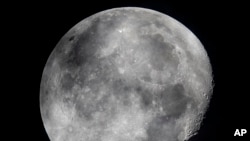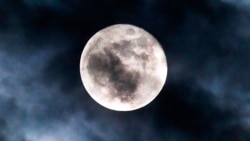A new study suggests sources of water on the moon are more widespread than previously thought.
The study was based on new examinations of data collected by India’s Chandrayaan-1 spacecraft. It launched in October 2008 and collected data while orbiting the moon for about a year.
Chandrayaan-1 has already provided evidence of water on the moon. In September 2009, scientists published a study based on data from the Indian space mission. The data showed the presence of molecules linked to water, as well as the substance hydroxyl.
The American space agency NASA describes hydroxyl (OH) as “a molecule made up of one hydrogen atom and one oxygen atom with a free (unpaired) electron.” It notes it is “one of the most reactive gases in the atmosphere” and can help break down other gases in the air.
The 2009 study suggested the water molecules identified by Chandrayaan-1 data were mainly found in the moon’s extreme northern and southern areas, known as the poles. Scientists said the data from that study showed most of the water probably existed in large craters near the poles where sunlight is blocked.
But new examinations of the data show that water and hydroxyl molecules likely exist over much wider areas of the moon. In addition, the research suggests water is even present in areas of the moon receiving direct sunlight.
The instrument aboard Chandrayaan-1 that captured the molecule data is called the Moon Mineralogy Mapper (M3). NASA built and operated the instrument. The space agency describes M3 as an “imaging spectrometer.” A spectrometer is an instrument used to study the chemical composition and structures of substances.
On the Chandrayaan-1 mission, the spectrometer aimed to map the mineral composition of materials on the moon’s surface. Researchers examined this data and centered their search on areas outside the lunar poles. They found that the sources of water and hydroxyl are believed to be contained in minerals on or just below the moon’s surface.
Scientists involved in the research recently reported their results in a study published in the Planetary Science Journal.
The research was led by Roger Clark, a senior scientist at the Planetary Science Institute.
In a press release announcing the findings, the researchers noted their discovery was made possible by data that the M3 instrument collected. They explained the instrument provides highly detailed data using imaging and infrared technologies.
The M3 instrument, for example, can identify 85 different colors in its examinations of mineral compositions. This compares to normal digital cameras, which generally only record three colors.
The researchers said, “Just like we see different colors from different materials, the infrared spectrometer can see many (infrared) colors to better determine the composition, including the water and hydroxyl."
The team noted the water might have resulted from heating of rocks and soil or from chemical reactions that combined different hydroxyls to produce water, as well as oxygen.
Clark, from the Planetary Science Institute, said both cratering and volcanic activity can bring water-rich materials to the surface. He noted that both are observed in the newly examined data. “We see a lunar surface with complex geology with significant water in the sub-surface and a surface layer of hydroxyl.”
The discovery, Clark said, can be helpful to future exploration efforts on the moon. “Future astronauts may be able to find water even near the equator by exploiting these water-rich areas.”
He added, “Knowing where water is located not only helps to understand lunar geologic history, but also where astronauts may find water in the future.”
I’m Bryan Lynn.
Bryan Lynn wrote this story for VOA Learning English, based on reports from the Planetary Science Institute and NASA.
___________________________________
Words in This Story
crater – n. a hole left in the ground by an object that hits it with a huge force
composition – n. the parts, substances, etc. that something is made up of
geology – v. the study of rocks and soil and the physical structure of Earth
exploit – v. to use or develop something for your advantage










Forum